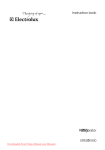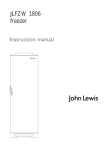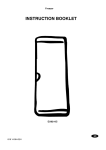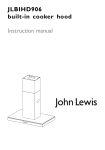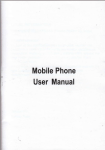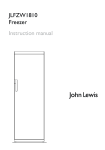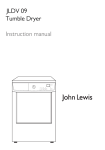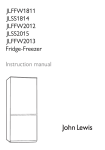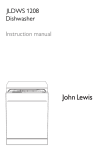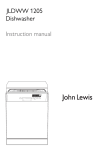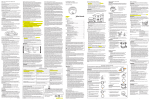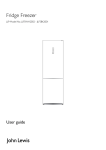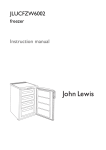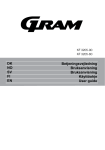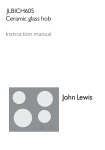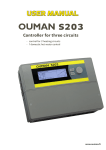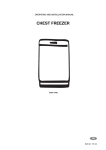Download Electrolux JLLFW 1805 User's Manual
Transcript
JLLFW 1805 fridge Instruction manual Important Safety Information It is most important that this instruction book should be retained with the appliance for future reference. Should the appliance be sold or transferred to another owner, or should you move house and leave the appliance, always ensure that the book is supplied with the appliance in order that the new owner can get to know the functioning of the appliance and the relevant warnings. These warnings have been provided in the interest of safety. You MUST read them carefully before installing or using the appliance. If you are unsure of the meanings of the these warnings contact the John Lewis branch from which you purchased the appliance. Installation Use D This appliance is heavy. Care should be taken when moving it. D Any electrical work required to install this appliance should be carried out by a qualified electrician or competent person. D Care must be taken to ensure that the appliance does not stand on the electrical supply cable. D Parts which heat up should not be exposed. Whenever possible, the back of the appliance should be close to a wall, but leaving the required distance for ventilation, as stated in the installation instructions D This appliance should be left for 2 hours after installation before it is turned on, in order to allow the refrigerant to settle D Before switching on the Fridge ensure that the interior light bulb and cover are in position. Do not connect the appliance if they are not. D This appliance is designed for domestic use only, specifically for the storage of edible foodstuffs only. It is not intended for commercial or industrial use. D Containers with flammable gases or liquids can leak at low temperatures. Do not store any containers with flammable materials, such as spray cans, fire extinguisher refill cartridges etc. in the refrigerator or the vicinity of the refrigerator or any other appliance. D Do not let sharp objects come into contact with the refrigerating system on the back of and inside the fridge. If the refrigerating system is punctured, the fridge will be damaged and foodstuff inside may spoil. D Do not use electrical appliances inside the Fridge. D Do not damage the refrigerant circuit. Maintenance and Cleaning D Before cleaning, always switch off the appliance and disconnect from the electrical supply D When unplugging always pull the plug from the mains socket, do not pull on the cable. D For information on maintenance and cleaning your appliance see page 15 of this Instruction manual. Child Safety D This appliance is designed to be operated by adults. Children should not be allowed to tamper with the controls or play with the product. D Keep all packaging away from children. D When the appliance is to be scrapped, cut off the electrical supply cable and destroy the plug with the remaining cable. Disable the door catch in order to prevent children from becoming trapped inside while playing. Service D This product should only be serviced by an uthorized engineer and only genuine spare parts should be used. D Under no circumstances should you attempt to repair the appliance yourself. Repairs carried out by inexperienced persons may cause injury or serious malfunction. 2 Ecological hints To save energy and help protect the environment, we recommend that you follow these hints. D Do not install the appliance close to sources of heat such as a boiler or radiator. D Locate the appliance in a well ventilated room and make sure that any air openings of the appliance are not obstructed. D Try to avoid keeping the door open for long periods or opening the door too frequently as warm air will enter the cabinet and cause the compressor to switch on unnecessarily often. D Ensure there are no obstructions preventing the door from closing properly. Environmental Information D After unpacking please dispose of the packaging with due regard to safety and the environment. D Materials marked with the symbol are recyclable. D Avoid damaging the cooling unit, especially at the rear near the heat exchanger. Check with your local Council or Environmental Health Office to see if there are facilities in your area for recycling this appliance. D When the appliance is to be scrapped, cut off the power supply cable and remove the door, to prevent young children from being trapped inside. D This appliance does not contain gases which could damage the ozone layer, in either its refrigerant circuit or insulation materials. Warning ! A cut off plug inserted into a 13 amp socket is a serious safety (shock) hazard. Ensure that the cut off plug is disposed of safely. The symbol on the product or on its packaging indicates that this product may not be treated as household waste. Instead it shall be handed over to the applicable collection point for the recycling of electrical and electronic equipment. By ensuring this product is disposed of correctly, you will help prevent potential negative consequences for the environment and human health, which could otherwise be caused by inappropriate waste handling of this product. For more detailed information about recycling of this product, please contact your local city office, your household waste disposal service or the shop where you purchased the product. 3 Contents For the User Important Safety Information For the Installer 2 • Installation Description of the Appliance Before use The Control Panel Using the fridge Hints and Tips Maintenance and Cleaning • Removing the ventilation grill 5 10 12 13 15 16 Installation 6 Technical Specifications 6 • Installation and changing the carbon filter 7 • Installing the cabinet 7 • Unpacking 7 • Door reversal 9 • Climate classification 10 Electrical connection 11 16 • Cleaning 16 • Defrostning the fridge 16 • Changing the light bulb • When the appliance is not in use 16 16 Something Not Working Repairs - After Sales Service Spare parts 17 18 18 Guide to using the Instruction Manual The following symbols will be found in the text to guide you throughout the instructions: Safety instructions Hints and tips Environmental information This appliance complies with the following E.E.C. Directives: - 73/23 EEC of 19.2.73 (Low Voltage Directive) and subsequent modifications; - 89/336 EEC of 3.5.89 (Electromagnetic Compatibility Directive) and subsequent modifications. 4 Description of the Appliance 12 4 3 7 2 8 11 1 8 9 1 5 5 1 8 1 10 1 5 1. 2. 3. 4. 5. 6. 7. 8. 9. 10. 11. 12. glass shelf quick chill shelf bottle- and can holder grid vegetable/sallad drawer ventilation grill butter compartment door shelf egg holder bottle shelf wine rack air circulation fan and regulator 6 5 Installation It is dangerous to alter the specifications or attempt to modify this product in any way Care must be taken to ensure that the appliance does not stand on the electrical supply cable. Any electrical work required to install this appliance should be carried out by a qualified electrician or competent person. Technical Specifications DIMENSIONS Width Height Depth 595 mm 1800 mm 623 mm VOLUME ELECTRICAL CONNECTION 335 l Information on the electrical connection is given on the rating plate on the inside of the appliance. ENERGY CLASS RATED POWER A 70W NOISE 40 db NET WEIGHT 71 kg 6 Unpacking Remove all packaging before positioning the appliance. Remove the tape and the transport supports from D the door sides D inside the door hinges D the shelves Remove the transport support on the glass shelf by pushing the support forward along the edge of the shelf until it stops. Take hold of the rear edge of the glass shelf and pull the shelf and transport support forward until the shelf tilts and the transport support can be removed. Some models are fitted with a silencing pad under the fridge. Do not remove this pad. Installation and changing the carbon filter To maintain the best performance the carbon filter should be changed once a year with normal usage. New carbon filters can be purchased from your local Service Force office. On delivery the carbon filter is placed in a plastic bag to secure the length of life of the carbon filter. Remove the bag and the filter should be placed behind the grill before the fridge is turned on. The cover can be opened by simultaneously pressing the lever on the right of grill (1) and turning the cover outward (2). The carbon filter is then mounted (3) in the slot found in the back of the cover. The filter should be handled carefully so carbon fragments don't loosen from the surface. Installing the cabinet When two appliances are placed beside each other, the spacers enclosed in the plastic wrapping should be glued between the appliances. As shown in the illustration. Make sure that the power plug is not squashed or damaged by back of the product. D A damaged power plug may overheat and cause a fire. Do not place heavy articles or the product itself on the power cord. D there is a risk of a short circuit and fire. If the power plug socket is loose, do not insert the power plug. D there is a risk of electric shock or fire. If the fridge is placed in a corner and the side with the hinges facing the wall, the distance between the wall and the fridge must be at least 230 mm to allow the door to open enough so that the shelves can be removed. Check that the drain hose at the rear of the fridge discharges into the drip tray. The power plug must be accessible after installation of the fridge . 7 1 2 3 To obtain the best performance from the fridge, ensure : D the fridge is placed in a dry, cool place and is not exposed to direct sunlight. D the fridge is not placed close to a source of heat, e.g. a cooker or dishwasher. D the fridge is level. The fridge should not lean against any wall. If necessary adjust the feet using the adjustment spanner supplied. D there is good air circulation around the fridge and that the air channels below and behind the fridge are not blocked. The ventilation space between the fridge and a cupboard above must be at least 40mm. The ventilation space can either be a) directly above the fridge, or b) If a cupboard is placed immediately above the fridge there should be a ventilation gap behind the cupboard of 50mm deep and at least a 40mm gap between the top of the cupboard and the ceiling. If the fridge is placed in a corner and the side with the hinges facing the wall, the distance between the wall and the fridge must be at least 230 mm to allow the door to open enough so that the shelves can be removed. Check that the drain hose at the rear of the fridge discharges into the drip tray. The power plug must be accessible after installation of the fridge . 8 a) b) 50mm 1 Door Reversal 1. Close the fridge and remove the plug from the electrical socket. 2 2. Remove the ventilation grille. There is a part on the grille that can be removed. Remove and reposition it on the other side. 3 3. Put the fridge on a wooden board when it is laid down. Later, when raising the fridge, it will be easier to grip under the fridge thanks to the board. 4 4. On the upper part of the fridge. Put the hinge pin on the other side. 5. On the lower part of the fridge. a. Unscrew the hinge. b. Remove the door-closing fittings from the hinge and put the hinge pin on the other side. Then attach the supplied door-closing fitting. 5a 5b 6. a. Remove the door-closing fitting from the bottom of the door. b. Remove the plastic plug from the corresponding hole on the other side. Use a screwdriver to rock the plug loose. Then secure the supplied door-closing fitting. c. Secure the lower hinge. Remove any play in the door by adjusting the height of the lower hinge with the supplied spanner. Secure with the lock nut. 6 a b c 7. Raise the cabinet and replace the ventilation grille. 8. To transfer the handle. Unscrew the screws. Fit the handle onto the opposite side by turning it one half circle. Press the supplied plastic plugs into the holes to which the handle was previously fitted. 8 9. Put the fridge in position. Check that the appliance is level. See the section "Installing the fridge". 9 Climate classification Fridge is placed at a location whose ambient temperature corresponds to the climate classification*, for which the appliance is designed. * See on the rating plate on the inside of the appliance. The following table shows which ambient temperature is correct for each climate classification. Climate classification SN for an ambient temperature of +10°C to +32°C N +16°C to +32°C ST +18°C to +38°C T +18°C to +43°C Before use Position and clean the fridge as explained in the section "Installation". Check that the drain hose at the rear of the fridge discharges into the drip tray. Before inserting the power plug into the outlet and switching on the freezer for the first time, leave it standing upright for about 4 hours. This time will allow the oil sufficient time to return to the compressor. Otherwise the compressor may sustain damage 10 Electrical connection Any electrical work required to install this appliance should be carried out by a qualified electrician or competent person. 4. Upon completion there must be no cut, or stray strands of wire present and the cord clamp must be secure over the outer sheath. WARNING: A cut off plug inserted into a 13 amp socket is a serious safety (shock) hazard. Ensure that the cut off plug is disposed of safely. WARNING: THIS APPLIANCE MUST BE EARTHED. Should the appliance power supply cable need to be replaced, this must be carried out by a Service Force agent (see page 18). The manufacturer declines any liability should this safety measure not be observed. The plug must still be accessible after the appliance has been installed. Before switching on, make sure the electricity supply voltage is the same as that indicated on the appliance's rating plate.The rating plate is located on the inside of the appliance. The appliance should not be connected to the electrical supply by means of an extension cable The appliance is supplied with a 13amp plug fitted. In the event of having to change the fuse in the plug supplied, a 13amp ASTA approved BS 1363/A fuse must be used. Should the plug need to be replaced for any reason, proceed as described below. The wires in the mains lead are coloured in accordance with the following code: Green and Yellow - Earth Blue - Neutral Brown - Live Permanent connection In the case of permanent connection it is necessary that you install a double pole switch between the appliance and the electricity supply (mains), with a minimum gap of 3mm between the switch contacts and of a type suitable for the required load in compliance with the current electrical regulations. The switch must not break the yellow and green earth cable at any point. GREEN & YELLOW 13 A E N L BROWN BLUE P1041 CORD CLAMP If you fit your own plug, the colours of the wires in the mains lead of your appliance may not correspond with the markings identifying the terminals in your plug. Proceed as follows: 1. Connect the Green and Yellow (earth) wire to the terminal in the plug which is marked with the letter "E" or the earth symbol or coloured green and yellow. 2. Connect the Blue (neutral) wire to the terminal in the plug which is marked with the letter "N" or coloured black. 3. Connect the Brown (live) wire to the terminal in the plug which is marked with the letter "L" or coloured red. 9 The control panel 5 1 1. Refrigerator power switch Switches the refrigerator on and off. 2. Temperature display Shows the average temperature inside the refrigerator. 3. Temperature adjustment button/thermostat Used to set the temperature in the refrigerator. 4. QUICK CHILL button Used to switch the Quick chill feature on and off. 5. Yellow indicator lamp Lights when Quick chill is operating. 6. Alarm shut-off button Used to turn the audible alarm off. 7. Red warning lamp Flashes when one of the alarms in the fridge has been triggered. 12 2 ACTION COOL 3 4 5 6 7 Using the fridge To start the fridge and setting the correct temperature Switching on: Switch on the fridge by pressing the power switch. Setting the temperature Press the buttons until the desired temperature flashes in the temperature display (The temperature can be set between +2°C and +8°C.) "+" raises the temperature. "-" lowers the temperature. Once set, the temperature display shows "-" until the temperature inside the fridge reaches +9°C or below. Allow the fridge to run for a period of 24 hours whenever the temperature setting is changed. This will allow the temperature to stabilise inside the fridge. It is not necessary to reset the temperature when the fridge is switched on after it has been out of use. The thermostat recalls the previously set temperature. 5 ACTION COOL 5 ACTION COOL Temperature inside the fridge A suitable temperature inside the fridge is approx. +5°C. Storage temperature in the fridge is even on all of the shelf levels. The vegetable/sallad drawer which is placed in the bottom has a temperature of 3-4°C warmer than the selected temperature setting. Measuring the temperature If the temperature is measured using a standard, single thermometer, this should be put in a glass of water centrally placed inside the fridge. This will reflect the temperature inside the food products. Do not place the thermometer hanging or lying directly on the shelf. Hints: D Distribute foodstuffs to allow cold air to circulate freely between the products. D Also never put warm (freshly cooked) products into the fridge. Wait until they have cooled down. D Cover all foods properly. Alarms and other features Door open alarm If the fridge door remains open for more than 5 minutes, the red warning lamp starts flashing and you will hear an audible alarm sound. To switch off the alarm: Press the "alarm shut-off button". The red warning lamp goes out when the door is closed. Quick chill This function has two usage areas. One area in connection with cans / bottles being quickly chilled on the quick chill shelf, and the other in connection when large amounts of food at room temperature being placed within the fridge. 5 13 ACTION COOL Chilling of cans/bottles: When cans and bottles are placed on the shelf (see under section; bottle and can holder and Quick chill shelf) the air regulator should be turned to it's maximum position, then press the Quick chill button. This will be indicated in the symbol window with a "C" and by the yellow lamp being lit. Chilling of warm groceries: This function is used in connection with large amounts of groceries at room temperature being placed in the fridge. Pressing the Quick chill button starts this function. This will be indicated in the symbol window with a "C" and by the yellow lamp being lit. When this function has been activated forced air will chill the groceries, and the temperature in the fridge reset to +2°C. After 6 hours the Quick chill automatically shuts off and the temperature gradually goes back to its normal setting. ! It is good practice to switch on the Quick chill prior to shopping and re-select once the food has been placed inside. Carbon filter's function: The built-in carbon filter means that strong smelling groceries can be placed near other groceries without affecting their taste or aroma. MAX MIN C ACTION COOL Switching off Switch off the fridge by pressing the power switch. Keep the button pressed for approx. 1 second. Power to the fridge is completely interrupted only when the power plug is disconnected. 5 Fridge interior The shelves and door compartments are removable and can easily be re-arranged. Certain shelves must be lifted up by the rear edge to enable them to be removed. The lower door compartment and the glass shelf above the vegetable/sallad drawer must not be moved to an alternative position. They are required for proper air circulation inside the fridge. Shelves with a raised edge should be placed with the raised edge facing the rear wall of the fridge. The vegetable drawer has a removable ventilation edging to increase the circulation of air, retaining humidity in the drawer and reducing condensation. The vegetable drawer has two moveable partitions with five different positions in order to separate different vegetables. 14 ACTION COOL Bottle and can holder The bottle and can holder is moveable sliding to the left or right, or front to back to enable a more flexible placement of cans and bottles in front of the grid. To allow the holder to be moved easier, when moving sideways, press the shelf backwards. During chilling of cans or bottles the holder should be centrally placed in front of the grid to obtain the best chilling effect. The bottle support can be pulled out when chilling larger bottles. For a description of this functions start and stop, see under heading Quick Chill. Quick chill shelf: The lower Quick chill shelf can be placed in one of the upper grooves. To maintain the best performance the shelf should be placed in the second groove from the top. Dismantling of the bottle- and can holder. Take out the Quick Chill shelf with holder from the fridge. To loosen the holder from the shelf, bend the hooks/brackets that surround the backside of the shelf. Hints & Tips Food Storage D To obtain the best results from your appliance, neither hot foods nor liquids which may evaporate, should be placed in the larder compartment. D Remove suspect food from you refrigerator and clean, refer to cleaning and maintenance. 15 Maintenance and Cleaning You must disconnect the appliance from the electricity supply, before carr ying out any cleaning or maintenance work. Removing the ventilation grill The ventilation grill can be removed, e.g. to wash the grill. Make sure the door is open when removing the ventilation grill. Unsnap the upper edge of the grill by pulling outward/downward. Then pull the grill straight out to completely remove it. Cleaning Clean the freezer at regular intervals. Don't use detergents, abrasive powders, high perfumed cleaning products, wax polishes or cleaning products containing bleach or alcohol when cleaning the product Disconnect the appliance from electricity supply. Clean the inside and accossories with warm water and bicarbonate of soda (5ml to 0,5 litre water). Be careful when cleaning the inside of the fridge, due to fragile edges. Rinse and dry thoroughly. Regularly check the door seals and wipe clean to ensure they are clean and free from debris. Wash the inside of the fridge using lukewarm water, a mild washing-up detergent and a soft cloth. Wash the outer fridge with warm soapy water. Remove the ventilation grill (see above) and vacuum-clean under the fridge. Once or twice a year dust the condenser (grill) and the compressor at the back of the appliance, with a brush or vacuum cleaner, as an accumulation of dust will affect the performance of the appliance and cause excessive electricity consumption. When moving the fridge, lift it by the front edge to avoid scratching the floor. Defrosting the fridge The fridge is defrosted automatically every time the compressor stops. Frost formation can be prevented by: D not putting warm foodstuff inside the fridge. D avoiding frequently opening the door or keeping it open too long. To change the light bulb This fridge is fitted with a clear halogen light bulb. The light is switched on automatically when the door is opened. If the bulb fails and needs to be replaced; disconnect the power from the fridge. Cut the packaging containing the new bulb. Keep the packaging on to hold the bulb when setting it into the socket. Do not touch the bulb with your bare fingers. Halogen light bulbs are sensitive to grease from the skin. When the appliance is not in use Disconnect the appliance from electricity supply. Empty all foods and clean the appliance, leaving the doors ajar to prevent unpleasant smells. If the fridge will be kept on, ask somebody to check it once in a while to prevent the food inside from spoiling in case of a power failure. 16 G4 UV-blocked 20W/12V Low pressure Something Not Working If your Refrigerator is not working correctly, before contacting the John Lewis extended warranty administrators, check the following point. IMPORTANT: If you call out an engineer to a fault listed below, or to repair a fault caused by incorrect use or installation, a charge will be made even if the appliance is under guarantee. Sympton Solution " " is displayed in the temperature display. D An error has occurred in measuring the temperature. (The cooling system will continue to keep food products cold, but temperature adjustment will not be possible.) Contact the John Lewis extended warranty administrators, see service and spare parts page 18. It is too warm inside the refrigerator. D Set a lower temperature. D Put food products in the right place inside the refrigerator. See the chapter "Temperature inside the refrigerator". D Distribute the food products to allow cold air to circulate around them. D Make sure that the door is completely closed and that the insulating strip is complete and clean. It is too cold inside the refrigerator. D Set a warmer temperature. Water comes out on the floor. D Check that the drain hose at the back of the fridge above the drain bowl is in position. See the chapter "Before using the fridge the first time". The compressor operates continuously. D Set a warmer temperature. D Make sure that the door is completely closed and that the insulating strip is complete and clean. The fridge does not operate at all. Cooling or interior light does not operate. No indicator lamps light. D Power does not reach the fridge. (Try connecting another electrical device to the power outlet.) D The fridge or power socket is not switched on. D The fuse has blown. D The power plug is not properly inserted into the socket. Sound level in fridge is too high. D The refrigerating system will always produce some sounds. A pulsing sound; A ticking sound and The sound level. A pulsing sound is heard when coolant is pumped inside the cooling pipes. A ticking sound from the thermostat can be heard when the compressor switches on and off. The sound level varies depending on the operation of the fridge. If you feel the sound level is incorrect: D Make sure the pipes at the back of the fridge not touch each other. Carefully bend them if they do. D If the cushion spacers (between the fridge wall and pipes) come loose, put them back in place again. D Carefully follow the instructions in the chapter "Installing the fridge". If after above checksthere is still a fault ccontact the John Lewis extended warranty administrators, see page 18 for details. In-guarantee customers should ensure that the above checks have been made as the engineer will make a charge if the fault is not a mechanical or electrical breakdown. Please note that proof of purchase is required for in-guarantee service calls. 17 Repairs - After Sales Service In the unlikely event of your appliance requiring service, or if you wish to purchase spare parts, please contact our local Service Force Centre by telephoning: 0870 010 7887 They will give you details for your local Service Force Centre. Before calling out an engineer, please ensure you have read the details under the heading "Something Not Working". When you contact your local Service Forse Centre you will need to give the following details: 1. Your name, address and post code 2. Your telephone number 3. Clear and concise details of the fault 4. The purchase date and found on your receipt. 5. The model and serial number of the appliance (found on the rating plate) So that you always have these numbers at hand, we recommend you to make a note of them here: Mod:................................................. PNC:................................................ S.N.:................................................. Your fridge is covered by a 3 year parts and labour guarantee (see separate details given at point of sale). Please retain your purchase receipt safely for the service engineer to verify the purchase details. Spare Parts Always insist on genuine spare parts. An authorised service engineer should service this product, and only genuine spare parts should be used. Under no circumstances should you attempt to repair the machine yourself. Repairs carried out by inexperienced persons may cause injury or serious malfunctioning. Contact your local Service Force Centre. An authorised service engineer always insist on genuine spare parts. 18 19 John Lewis Partnership 171 Victoria Street London SW1E 5NN www.johnlewis.com 05/06 8183856--00/3




















